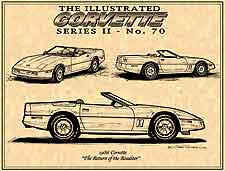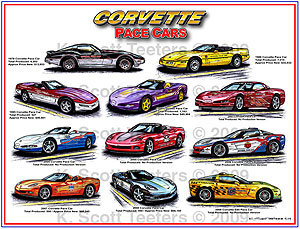Dateline: 10.7.11
A Look Back at the Most Common and Overlooked Corvette Pace Car
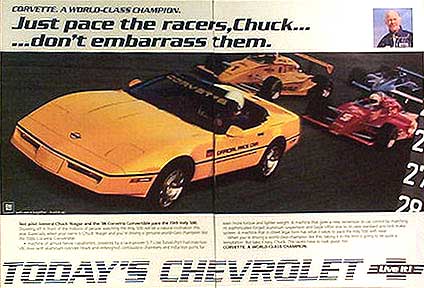 1986 was a banner year for Corvette fans with the return of the roadster. The ‘70s was an awful time for performance cars and “fun” cars in general. Between new strict emission controls, sky rocketing gasoline prices (all the way up to 50¢ a gallon! in ‘73), reduced performance, and increased safety concerns, it was not a good time. Convertibles also went down the drain too. Beginning in the Fall of ‘75 with the ‘76 model, there were no more Corvette roadsters. After 22 years, the Corvette Roadster was dead.
1986 was a banner year for Corvette fans with the return of the roadster. The ‘70s was an awful time for performance cars and “fun” cars in general. Between new strict emission controls, sky rocketing gasoline prices (all the way up to 50¢ a gallon! in ‘73), reduced performance, and increased safety concerns, it was not a good time. Convertibles also went down the drain too. Beginning in the Fall of ‘75 with the ‘76 model, there were no more Corvette roadsters. After 22 years, the Corvette Roadster was dead.
So in ‘85 when it was announced that the roadster would be returning, Corvette fans couldn’t be happier. But unlike the olden days when a convertible Corvette cost LESS than a coupe (the ‘75 convertible cost $6,550 and the coupe cost $260 more than the roadster!), the ‘86 Corvette convertible cost an additional $5,005! Unlike the C2 and C3 chassis and body structure, the C4 was not originally designed to be a topless car. Coupe to convertible conversions usually have the characteristic cowl shake and sometimes ride more like wiggle wagons where the driver can actually see the dash shake on bumpy twisty roads. The solution for the C4 was to add a large X-brace to stiffen the chassis.
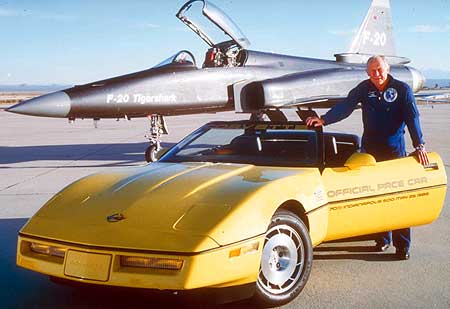 The second piece of big news for ‘86 was that a Corvette would pace the Indy 500 for the second time. Retired General Chuck Yeager was enjoying celebrity status as a result of the book and movie, “The Right Stuff.” But Chevrolet was still smarting from the heavy criticism over the ‘78 Corvette Pace Car debacle and seemed to go in the opposite direction. Rather than producing a set number of pace car relicas, ALL ‘86 Corvette convertibles were designated as a “Pace Car Replica” and came with dealer or customer applied decals for the doors. Many said, “Why bother.”
The second piece of big news for ‘86 was that a Corvette would pace the Indy 500 for the second time. Retired General Chuck Yeager was enjoying celebrity status as a result of the book and movie, “The Right Stuff.” But Chevrolet was still smarting from the heavy criticism over the ‘78 Corvette Pace Car debacle and seemed to go in the opposite direction. Rather than producing a set number of pace car relicas, ALL ‘86 Corvette convertibles were designated as a “Pace Car Replica” and came with dealer or customer applied decals for the doors. Many said, “Why bother.”
By the end of the year, 7,315 of the 35,109 Corvettes were convertibles (20%), all considers “pace cars” regardless of the color of the car. The actual Indy 500 Pace Cars were all yellow and 732 yellow convertibles were sold for the year. No special embroidery, wheel centers, stripes, spoilers… just a set of decals. Consequently, of the six Corvette pace car replicas offered from ‘78 to ‘08, the ‘86 model is the least valuable. Most of the ‘86 Corvette convertible “Pace Cars” never had their decals applied.
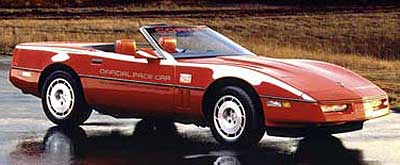 Oh well. When the next Corvette Pace Car came along in ‘95, there was no missing this car and only 527 cars were built. The ‘86 Indy 500 Corvette Pace Car was so understated that when I covered the car as Illustrated Corvette Series No. 70, it was just part of the general coverage of the ‘86 model and not a dedicated story about the Pace Car. Below is the story as it appeared in the April 2003 issue of VETTE Magazine. Enjoy!- Scott
Oh well. When the next Corvette Pace Car came along in ‘95, there was no missing this car and only 527 cars were built. The ‘86 Indy 500 Corvette Pace Car was so understated that when I covered the car as Illustrated Corvette Series No. 70, it was just part of the general coverage of the ‘86 model and not a dedicated story about the Pace Car. Below is the story as it appeared in the April 2003 issue of VETTE Magazine. Enjoy!- Scott
Illustrated Corvette Series No. 70 – “The Return of the Roadster
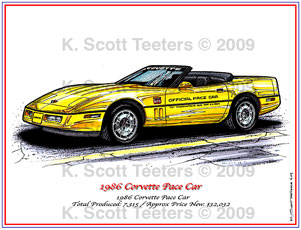
Outside the Corvette community, Harley Earl is mostly known for his Buick and Cadillac cars. Earl also created the GM Motorama to showcase advanced designs for possible future GM cars. For car people in the ‘50s and ’60s, this was pure automotive magic. The Corvette was Harley’s dream of an American sports car to compete with Europe’s best – at least, in the styling department. Right from the beginning, the seriously underpowered Corvette was a roadster. Thirty years later, when Dave McLellan and his design staff were working on the new C4 Corvette, they had in mind that the C4 Corvette might soon become a roadster again.
Since the basic C4 frame was designed with a possible future convertible in mind, major changes to the structure were not required. All that was needed was an x-brace on the frame, larger k-braces, thicker sections on several connecting bars, and a few other minor additions. The x-brace under the bottom of the main frame required that the ride height be increased by 10mm. The American Sunroof Company was contracted to work out the details of the top mechanism and everything else was developed by the Corvette engineering team. Extra space was needed for the convertible top, so the gas tank size was reduced from 20 gallons to 18 gallons.
There was a much-anticipated major change under the hood as well for ’86 – aluminum heads. What was once exotic in the ’60s with the L88 and L89 427 big-blocks, was now stock. The new cylinder heads shaved 40 pounds off the front end. It would be another 11 years before an all-aluminum engine would become standard. Other engine changes included triple catalytic converters and an increase in compression from 9:1 to 9.5: 1. The net result was a 5-hp increase to 235 hp.
The only visual change for ‘86, besides the roadster version, was the mandated third brake light. Most cars had tacked-on third break lights, but the roadster had a very nicely integrated light at the top edge of the rear bumper cover. The suspension setup on the roadster was stiffer than a stock Corvette, but not as stiff as a Z51 optioned car, and all roadsters got the wider Z51 wheels. ABS braking was standard on all Corvettes for ’86. Journalists loved the handling of the new roadster, but everyone had to get used to the “thumper” ABS brake system. The only changes in the interior were slightly angled instruments for better day-time readability and an all-new electronic air- conditioning system. A new cloth material was used for the stock seats.
The new roadster picked up some extra kudos by pacing the Indy 500 for the second time. The last time a Corvette paced the 500 was in ‘78, and boy, did Chevrolet create a kafuffle. Only 300 ’78 Pace Car Replicas were planned, but after dealers howeled, Chevrolet decided to build one for every dealer – with 6,502 built for the year. Speculators went wild and some dealers wanted double the list price for their Pace Car. So, when it came time for another Pace Car replica, Chevrolet decided that ALL ‘86 Corvette roadsters would be “pace car replicas” with a set of dealer or customer applied decals to prove it.
Aside from the obvious visual difference of the convertible top, the only other exterior change was several new colors and slightly revised wheels. The new wheels now had a brushed finish on the center section. All of the wonderful changes came at a very hefty price. The stock Corvette was up $2,624 from the ’85 price to $27,027. The roadster was a $5,005 option that hiked the price to $32,032! Sales dropped from 39,729 the year before, to 35,109 in ’86, with 7,315 “Pace Car replicas” convertibles built. But it didn’t matter, the rave reviews and the sheer open-air, driving fun of the new roadster was well worth the wait. – KST
PS – Prints of the ‘86 Corvette are available HERE.
And if you’re a fan of Corvette Pace Cars, all of the cars are covered HERE.
Here’s the BEST way to keep up with K. Scott Teeters’ Corvette blog!



